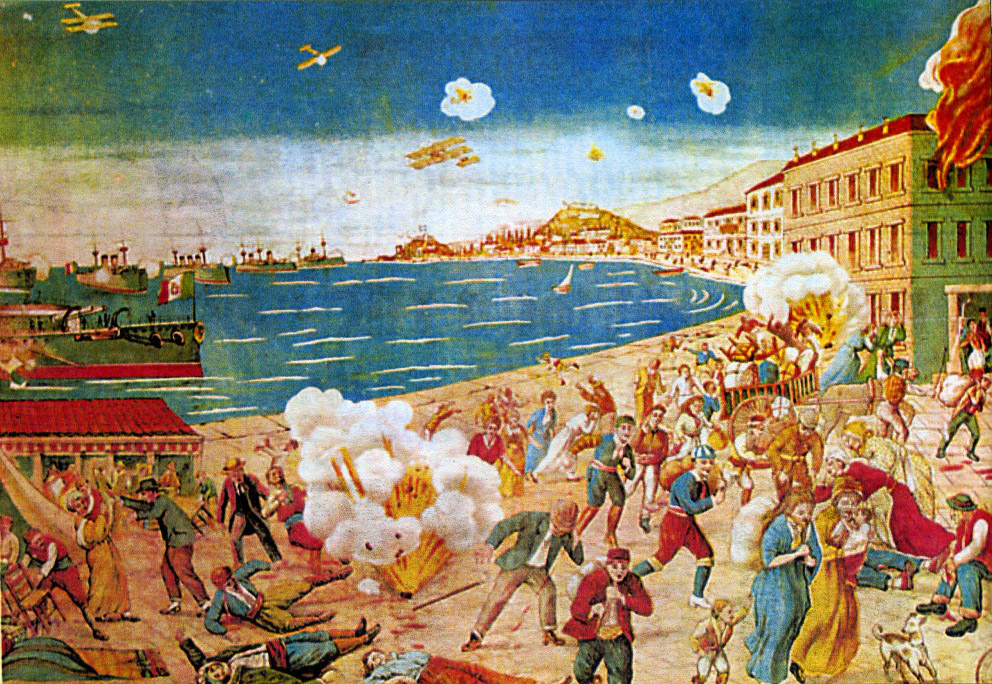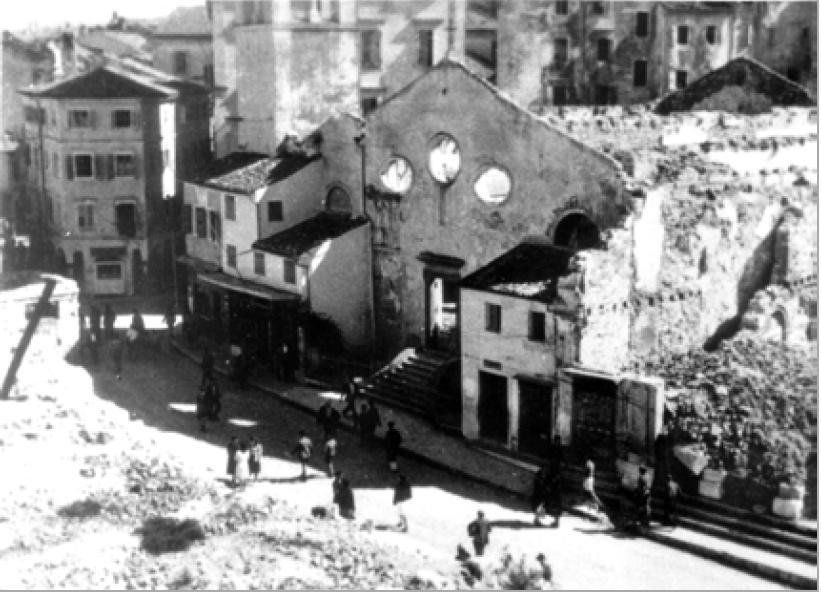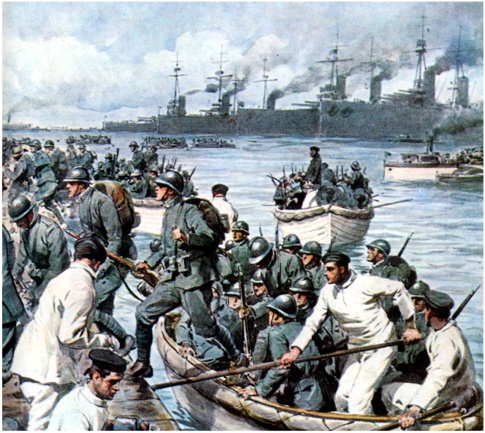cross‐posted from: https://lemmygrad.ml/post/1577976
In 1923, the Fascists occupied Corfu for twenty‐eight days, and only evacuated after Athens met Rome’s terroristic demands. While four weeks of occupation may seem ‘insignificant’ to some, this show of force should have been a warning to Europe that the Fascists meant business, and that they did not have to limit their exploits to Africa; it was a step towards their dream empire. Quoting from J. S. Papafloratos’s The Fiume and the Corfu Incidents:
On August 27th, 1923, the members of the international commission for the delineation of the Greek–Albanian borders started out in automobiles to do their work once again. The Italian car was last in the line and three officers, an interpreter and a driver were riding in it. In the 54th km, near Zepi (inside the Greek territory), unknown persons ambushed and killed General Enrico Tellini and the other members of the Italian delegation.
The murderers then evidently crossed the border and escaped in Albania. The name and the nationality of the murderers are still unknown⁹. In [Fascist] Italy, there was a perfect flare‐up of national pride and patriotic sentiment¹⁰. Mussolini at once drew up and sent out an ultimatum to the Greek government (on August 29th). He assumed, without a proof, that the responsibility for the murder belonged to the Greeks. The demands made in the ultimatum were extremely severe and the Greek government, by common consent outside of Italian circles, could not accept them¹¹.
The comparison with the Austro‐Hungarian ultimatum sent to Serbia in July 1914 was inevitable¹². The isolated Greek government¹³ accepted the ultimatum partially, because the Greek responsibility for the crime had not been proved. The resent research proved that Mussolini did not wait for the official reply of the Greek government and he had ordered a fleet of more than fifteen battleships to occupy the island of Corfu, on August 31st.
Although the [Duce] did not authorize the use of force against a demilitarized island, the [Fascist] commander Admiral Solari ordered the bombardment of the two castles of the island relating to the Middle Ages. These castles were full of refugees from Asia Minor. As a result, fifteen women and children were killed. This incident aggravated the diplomatic position of [Fascist] Italy. On September 1st, the Greek government appealed to the League of Nations without making any reference at the bombardment and the innocent victims in Corfu. Fiume and Corfu were already connected as aspects of [Rome’s] Balkan policy. But, the Greek recourse to the League of Nations made their interaction even stronger.
Pictured: The Church of Annunciata shortly after the Fascists bombarded it.
Pictured: Artist’s impression of the (first) Fascist invasion of Corfu.Mussolini was very happy to see that there was no agreement between Athens and Belgrade. Momcilo Ninčić, was keen to reconcile with Italy and he said that his government would send no troops in the area⁴⁸. A day earlier, Lord Curzon, then Foreign Minister of the British government, had accepted the French plan for the evacuation of Corfu.
According to this, the Greek government was found guilty for the murder of the members of the Italian delegation. The Greek government should compensate the [Fascist] one without receiving any satisfaction for the murdered refugees from Asia Minor, who were killed by the [Fascist] bombs. On September 27th, the Greek government was obliged to accept the decision of the Conference of Ambassadors in order to liberate Corfu. Mussolini’s new foreign policy appeared to be effective.
As long as the Fiume case was concerned, on January 27th, 1924, the Treaty of Rome was signed. The Kingdom of Serbs, Croats and Slovenes formally recognized Italy’s full and entire sovereignty over the city and the port of Fiume. The rest of the Free State together with port Baros was ceded to Slovenia in conformity with the pledges given by Count Sforza.
To this agreement was added, at Belgrade’s request, a general treaty of friendship, which bound both countries to preserve the peace settlement. Italy ratified the Fiume agreement on February 22nd. On the same day, a Royal Decree annexing Fiume to the Kingdom of Italy appeared in the Official Gazette⁴⁹. Mussolini was rewarded with the Collar of the Annunziata Order, the highest distinction, which the King could bestow on him⁵⁰.
He […] followed a very clever policy in order to achieve his goal. Mussolini succeeded in receiving a compensation for the murder of the members of the Italian delegation in Kakavia and he was capable to avoid to loose face in the League of Nations. Moreover, he managed to annex Fiume to [Fascist] Italy. He used the French uneasiness in Ruhr in order to secure Paris’ assistance as long as Belgrade was concerned.
It is true that the French government used all its influence in Belgrade in order to persuade it to compensate and not to form a Balkan bloc with Athens. In addition, the [Duce] took advantage of the internal decline and the division among the nations of the Kingdom of Serbs, Croats and Slovenes and the external isolation of the Greek government. He also realized the effect of the use of force upon a weak and unstable government such as the Greek one of that time.
It is doubtful if he could persuade the Serbs to retreat without the bombardment of Corfu, which proved his will to adopt any possible measure. On the other hand, the League of Nations acted in a very insufficient way in order to fulfill mainly the interests of the Great Powers. The well‐known tendency of the Balkan history to separate the states according to the will of the Great Powers was also proved. Viewed in retrospect, this bombardment was the key to unlock Fiume’s door.
(Emphasis added in all cases.)
Unfortunately, this would not be the only time that Fascism came to Corfu. Thanks to the Third Reich’s assistance, these Fascists reoccupied Corfu on April 1941.
Further reading: France and the Corfu–Fiume Crisis of 1923, ‘Consistently with Honour’: Great Britain, the League of Nations and the Corfu Crisis of 1923, Ireland and the Corfu Crisis, 1923 & The Corfu Incident of 1923: Mussolini and The League of Nations
Click here for other events that happened today (August 31).
1932: The Fascist cruiser Bolzano was launched at Genoa.
1933: Werner von Blomberg received the rank of Generaloberst.
1935: In an attempt to stay out of the growing tensions concerning the Third Reich and the Empire of Japan, Washington passed the first of its Neutrality Acts.
1936: The Fascist submarine Iride attacked British destroyer HMS Havock off Spain, and HMS Havock responded with depth charges, but neither incurred any damage. On the other hand, the Battle of the Sierra Guadalupe ended in a tactical Nationalist victory, and a Nationalist radio broadcast from Seville announced the executions of sixty‐seven miners at Rio Tinto for supplying Republican forces with munitions. Coincidentally, an explosion at a mine in Bochum killed twenty‐nine workers. The Japanese Navy Kanoya Air Group, based in Taiwan, launched nine Type 96 G3M2 bombers to attack Guangzhou.
1938: Winston Churchill suggested that if United Kingdom, United States, and Soviet Union collectively asserted pressure on the Third Reich, Berlin might abandon its claims for the Sudetenland region of Czechoslovakia, yet he was unable to persuade fellow British politicians! Aside from that, the Fascists commissioned Aviere into service, and Akagi completed her modernization, emerging with the three flight decks removed. In their place was a single flight deck running nearly the length of the ship, and aircraft capacity increased from sixty‐one to ninety‐one.
1939: Berlin made an offer to London: the Third Reich would not risk war if Poland was willing to turn over Danzig and a small section of the Polish Corridor, and Poland was to allow a plebiscite for the remainder of the Polish Corridor in the near future; British Ambassador in Germany Nevile Henderson expressed that the United Kingdom, while desiring peace, could not sacrifice Poland to achieve that goal. Meanwhile, Henderson continued to press Poland to send a delegation to the Third Reich in a last attempt to negotiate peace over Danzig and the Polish Corridor. When Polish Ambassador in Germany Józef Lipski attempted to send Henderson’s message to Poland later in the evening, he found that the Fascists had cut telephone and telegraph communications to Poland. The Third Reich mounted a false flag attack on the Gleiwitz radio station, creating an excuse to assault Poland the following day.In the Kingdom of Italy, Galeazzo Ciano sent the United Kingdom and France a secret message noting that Kingdom of Italy would not fight should the Third Reich start a war over Poland, and Fascist official Hermann Göring hosted British Ambassador Nevile Henderson and Swedish businessman Birger Dahlerus at his home in Berlin for tea between 1700 and 1900 hours, during which the latter two made a last attempt to broker peace, but Berlin still formally ordered the Fascist invasion of Poland, and made specific instructions for Wehrmacht troops on the western border to avoid conflict with the United Kingdom, France, and the Low Countries. Lastly, the Imperialists lost their 23rd Infantry Division at Nomonhan.
1940: At 0206 hours, Fascist submarine U‐59 sank British ship Bibury, killing the entire crew of thirty‐eight and one gunner. At 0615 hours, Fascist submarine U‐38 sank British ship Har Zion; thirty‐three died but somebody survived (rescued by Polish destroyer Blyskawica on the next day). Northwest of Ireland, Fascist submarine U‐46 sank Belgian passenger ship Ville de Hasselt, but the entire crew survived on four lifeboats. Before noon, two hundred Fascist bombers attacked Essex; № 56 Squadron RAF shot down one bomber but lost four fighters to Fascist escort fighters from III./ZG26 and III./JG26. Debden, North Weald, Eastchurch, Dietling (strafed by fighters), Croydon (bombed by Bf 109 fighter‐bombers of Erprobungsgruppe 210), and Hornchurch were all attacked in the morning. In the afternoon, the Fascists reattacked Hornchurch, destroying two Spitfire fighters on the ground but at the cost of five Bf 109 fighters. At 1800 hours, the Fascists bombed Biggin Hill from low level, destroying two of the three remaining hangars, cutting telephone lines, and destroying the operations room. On this day, the Luftwaffe lost fifty‐six fighters and twenty‐nine bombers. After sundown, the Fascists bombed Liverpool for the fourth consecutive night; other cities received bombs, too.
1941: Axis bombers attacked Alexandria, Egypt, killing two British Royal Navy officers but otherwise doing little to no damage to ships and port facilities, which were the primary targets. The Wehrmacht also lost the Battle of Loznica to Serbian paramilitary forces.
1942: Berlin ordered Wilhelm List to launch a major offensive to gain the Caucasus region in southern Russia, and tanks from the 4th Panzer Army reached the Stalingrad–Morozovsk railway on Stalingrad’s outskirts. Hans‐Joachim Marseille shot down two Hurricane fighters during the morning sortie over El Alamein, Egypt at 1003 and 1004 hours. In the afternoon sortie, he shot down a Spitfire fighter over Alam Halfa, Libya at 1825 hours. His score by the end of the day stood at 104. Axis and British tanks meanwhile engaged in combat near Alam el Halfa, Egypt, reaching no conclusion by nightfall as the British refused to fight in open terrain as the Axis wanted. The Axis broke off the attack at sundown after losing twenty‐two tanks.
1943: Berlin authorized limited withdrawals in Ukraine, and Heinrich Prinz zu Sayn‐Wittgenstein received Oak Leaves to his Knight’s Cross. The Axis submarine U‐703 arrived at Narvik, Norway and dropped off four survivors of the Soviet freighter Dekabrist.
1944: In the early morning hours between 0300 and 0630 hours, German Air Force III K/G3 launched twenty V‐1 flying bombs with Gloucester, England as the target. Only eight got across and over the coast and six of these fell to earth in Suffolk and the other two in Essex. One of the bombs injured seven people in Suffolk near to Harleston. One bomb brought down by a fighter near the coast impacted near Whitstable in Kent seriously injuring four. One of the Heinkel bombers flown by Unteroffizier Lorenz Gruber crashed at Vossenberg in Belgium on the return flight, all the crew perished. This was the final operation of the of the month by the aircraft of III K/G3, they had flown 228 sorties for the loss of three aircraft, a better return from the previous month. As well, the Wehrmacht disarmed two divisions of Slovakian resistance fighters at Presov, Czechoslovakia.
1945: Tatsunosuke Ariizumi suicided aboard submarine I‐401 by taking a pistol to his mouth at 0420 hours. At 0500 hours, this submarine lowered its naval ensign while in Sagami Wan. Nobukiyo Nambu, the submarine’s commanding officer, secretly ordered his signal officer to burn the flag to prevent Allied capture.




